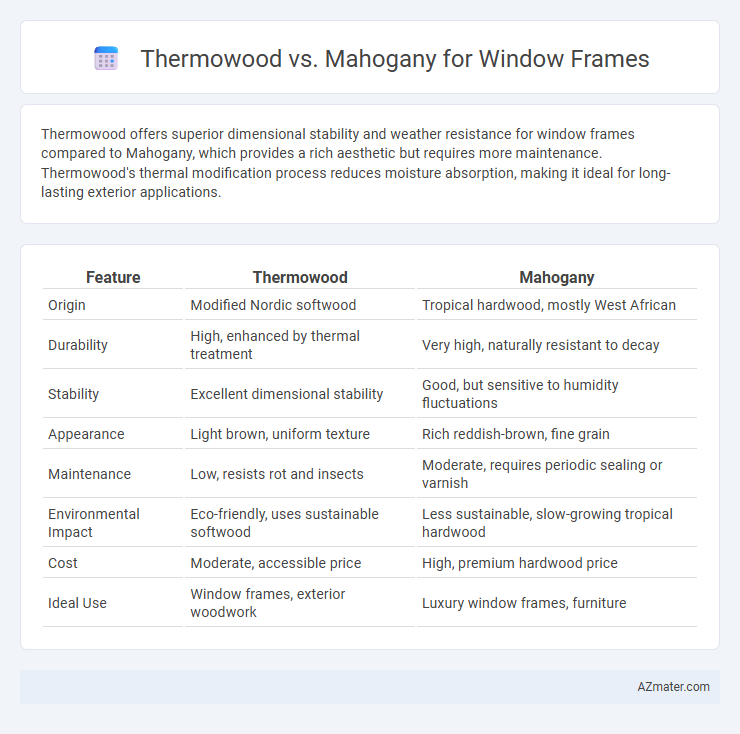Thermowood offers superior dimensional stability and weather resistance for window frames compared to Mahogany, which provides a rich aesthetic but requires more maintenance. Thermowood's thermal modification process reduces moisture absorption, making it ideal for long-lasting exterior applications.
Table of Comparison
| Feature | Thermowood | Mahogany |
|---|---|---|
| Origin | Modified Nordic softwood | Tropical hardwood, mostly West African |
| Durability | High, enhanced by thermal treatment | Very high, naturally resistant to decay |
| Stability | Excellent dimensional stability | Good, but sensitive to humidity fluctuations |
| Appearance | Light brown, uniform texture | Rich reddish-brown, fine grain |
| Maintenance | Low, resists rot and insects | Moderate, requires periodic sealing or varnish |
| Environmental Impact | Eco-friendly, uses sustainable softwood | Less sustainable, slow-growing tropical hardwood |
| Cost | Moderate, accessible price | High, premium hardwood price |
| Ideal Use | Window frames, exterior woodwork | Luxury window frames, furniture |
Introduction to Thermowood and Mahogany
Thermowood is a heat-treated wood known for its enhanced durability, stability, and resistance to moisture, making it ideal for window frames in variable climates. Mahogany, a dense hardwood prized for its rich color and fine grain, offers exceptional strength and natural resistance to decay and insects. Both materials provide distinct aesthetic and functional benefits, with Thermowood excelling in sustainability and environmental impact, while Mahogany is favored for its classic elegance and longevity.
Key Differences in Wood Composition
Thermowood is wood treated through a high-temperature thermal modification process, enhancing its durability, stability, and resistance to decay without chemicals, making it ideal for window frames exposed to moisture. Mahogany, a naturally dense hardwood with rich reddish-brown hues, boasts exceptional strength and fine grain but requires regular maintenance to prevent weathering and warping. The key difference lies in Thermowood's chemically unaltered profile versus Mahogany's natural oil content providing inherent weather resistance, influencing longevity and maintenance demands for window frames.
Durability and Weather Resistance Comparison
Thermowood offers enhanced durability and excellent weather resistance due to its heat-treated process that improves dimensional stability and reduces moisture absorption, making it highly suitable for window frames exposed to harsh climates. Mahogany, known for its natural strength and resistance to decay, provides long-lasting performance but may require more maintenance to preserve its weather-resistant qualities over time. Comparing both, Thermowood excels in minimizing warping and swelling in wet conditions, while Mahogany delivers superior density and aesthetic richness, offering a balance between durability and visual appeal for window frames.
Aesthetic Appeal and Color Variation
Thermowood offers a modern, uniform appearance with subtle natural grain patterns and a warm, honey-brown color that deepens over time due to the heat treatment process. Mahogany is prized for its rich, reddish-brown hues and pronounced grain variations, providing a classic, luxurious aesthetic that enhances window frames with its elegant, deep color palette. The color stability of Thermowood makes it ideal for contemporary designs, while Mahogany's dynamic tonal shifts suit traditional or high-end architectural styles.
Maintenance Requirements for Each Wood
Thermowood requires minimal maintenance due to its enhanced durability and natural resistance to rot and insects, often needing only occasional cleaning and re-oiling every few years to maintain its appearance. Mahogany demands more intensive upkeep, including regular sealing or varnishing to protect against moisture, UV damage, and insect infestation, typically requiring refinishing every 1 to 3 years depending on climate exposure. The superior dimensional stability of Thermowood reduces the risk of warping and cracking, making it a lower-maintenance option compared to the high-maintenance nature of mahogany in window frame applications.
Thermal Insulation and Energy Efficiency
Thermowood offers superior thermal insulation due to its lower thermal conductivity, effectively reducing heat loss and enhancing energy efficiency in window frames. Mahogany, while durable and aesthetically pleasing, has higher thermal conductivity, making it less efficient for insulating purposes. Choosing Thermowood for window frames supports better indoor temperature regulation and lowers heating and cooling costs.
Environmental Impact and Sustainability
Thermowood, produced through a heat treatment process using sustainable softwoods like pine or spruce, offers enhanced durability and resistance to decay without chemical additives, making it an eco-friendly choice for window frames. Mahogany, prized for its aesthetic and strength, often faces sustainability challenges due to deforestation and slow growth rates, impacting its environmental footprint. Choosing Thermowood supports responsible forestry and reduces carbon emissions related to chemical treatments, thereby promoting sustainable building practices.
Cost Analysis: Thermowood vs Mahogany
Thermowood offers a more affordable option for window frames compared to mahogany, with prices typically ranging from $15 to $25 per linear foot versus mahogany's $30 to $45 per linear foot. Maintenance costs for Thermowood are lower due to its enhanced durability and natural resistance to decay after heat treatment, reducing long-term expenses. Mahogany, while pricier, provides superior aesthetics and strength, which can increase initial investment but may last longer with proper care, affecting total cost differently over time.
Installation and Workability Considerations
Thermowood offers superior dimensional stability and ease of machining, making it highly suitable for precise window frame installation with minimal warping or cracking over time. Mahogany, while aesthetically appealing and durable, tends to be denser and requires more specialized tools and expertise for accurate cutting and shaping, increasing labor efforts. Both materials demand proper sealing and finishing, but Thermowood's engineered properties often result in faster installation and improved long-term maintenance efficiency.
Which Wood is Best for Your Window Frames?
Thermowood offers exceptional durability and resistance to moisture due to its heat treatment process, making it ideal for window frames exposed to harsh weather conditions. Mahogany provides a luxurious appearance with natural stability and resistance to decay but requires more maintenance to preserve its finish outdoors. Choosing the best wood for your window frames depends on balancing durability, maintenance, and aesthetic preferences, with Thermowood favored for low-maintenance resilience and Mahogany for rich, classic beauty.

Infographic: Thermowood vs Mahogany for Window Frame
 azmater.com
azmater.com